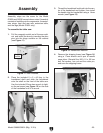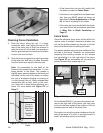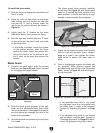
Model G0690/G0691 (Mfg. 11/10+)
-29-
To install the fence scale:
1. Slide the fence up against the saw blade and
lock it in place.
2. Place the front rail tape scale on the fence
tube, making sure it is parallel with the tube
and that the "0" end is directly under the
red line on the pointer window, as shown in
Figure 32.
3. Lightly mark the "0" location on the fence
tube with a pencil, then remove the fence.
4. Peel the tape and carefully align the "0" mark
on the scale with the pencil mark you made
on the fence tube.
—If you make a mistake, loosen the screws
on the pointer window, slide the fence
against the blade, adjust the pointer win-
dow so the red line on the window is over
the 0" mark on the tape, then secure the
screws.
Blade Guard
1. Reinstall the table insert, slide the knurled
knob out (see Figure 33) and rotate it forward
so it engages the upper bracket.
The blade guard, when properly installed,
should look like Figure 34, and should pivot
freely so it touches the table surface in the
down position. It should also swing up high
enough to accommodate the workpiece.
Set Screw
Figure 34. Blade guard installed.
4. Adjust the set screws to make sure the table
insert is flush with the table (use a straight-
edge as a guide), then tighten the button
head screw to secure the table insert in
place.
5. Place a straightedge against the blade and
the spreader. When properly aligned, the
spreader/riving knife will be in the "Alignment
Zone," shown in Figure 35, and will be paral-
lel with the blade.
Figure 35. Spreader/riving knife alignment zone.
Alignment
Zone
Spreader or
Riving Knife
Blade
— If the spreader/riving knife is not inside
the alignment zone and not parallel with
the blade, then it needs to be adjusted.
Proceed to "Adjusting Alignment" on Page
68.
— If the spreader/riving knife is not parallel
with the blade, it may be bent. Proceed to
"Checking Alignment" on Page 68 to deter-
mine if the spreader/riving knife is bent.
Button Head
Screw
2. Slide the blade guard spreader all the way
down into the adjustment block, then rotate
the knurled knob so it disengages the bracket
and the locking pin engages the hole in the
center of the spreader.
3. Give the spreader an upward tug to verify that
it is locked.
Figure 33. Knurled knob used to secure
spreader.
Adjustment
Block
Locking Pin
Knurled
Knob
Bracket


















